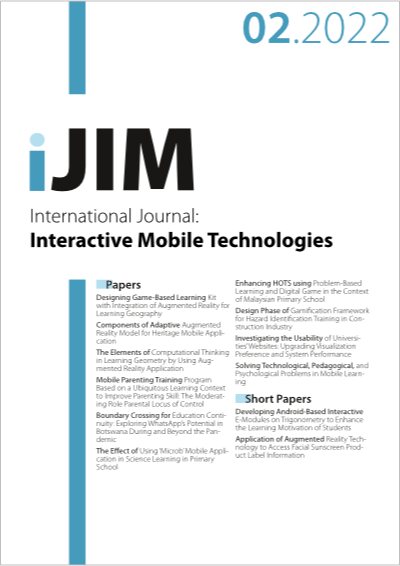Design Phase of Gamification Framework for Hazard Identification Training in Construction Industry
DOI:
https://doi.org/10.3991/ijim.v16i02.27405Keywords:
Game, Safety training, Hazard, FrameworkAbstract
Game has been proven an effective approach tool to improve learning and has become a new tool for training delivery. The development of the gamification framework involves integrating design processes which are input, process, and output. The design phase is considered essential to guide the flow of the gamification framework. It offers a safer, interactive, and entertaining learning environment for construction-related workers. This paper aims to report on the approach to design a gamification framework for hazard identification training in Construction using Garris's Input-Process-Outcome game model as the basis. It focuses on the three main design elements: instructional design, game characteristic, and user characteristic. The study outlines two objectives: (1) to identify the game's attributes and Gagne's Nine Events Instructional Methods Design which supports effective learning, and (2) to determine the user's characteristics of self-directed learning. This study focused on designing the Design phase, which consists of three main elements, i.e. instructional design, game characteristics and user characteristics. Mixed methods were used to extract the attributes and elements of the Design phase. Content analysis was carried out to determine the model of instructional design and game attributes. The findings show 12 attributes of the game through content analysis methods. Gagne's Nine Events Instructional Methods Design can support effective learning. Meanwhile, a questionnaire survey was subsequently administered to determine the user's ability to self-directed learning and decision-making style, where 319 construction-related workers responded. Data were analysed using mean comparison. The results showed that construction-related workers belong to the independent learners' category and are inclined to 'vigilant' and 'brooding' types of decision-making style. Findings confirmed that construction-related workers belong to the independent learners' category and are inclined to 'vigilant' and 'brooding' types of decision-making style. Following the aim of this paper, these findings were incorporated into the design phase of the game framework.
Downloads
Published
How to Cite
Issue
Section
License
Copyright (c) 2021 Norhazren Izatie Mohd, KHERUN NITA ALI, SHAMSULHADI BANDI, FUZIAH ISMAIL, KHEW KAI REN

This work is licensed under a Creative Commons Attribution 4.0 International License.



